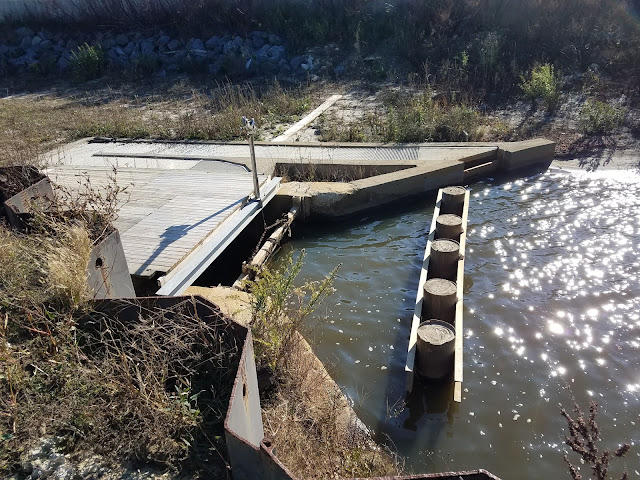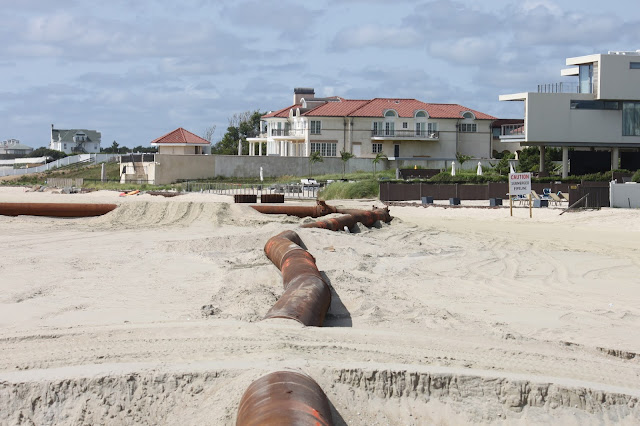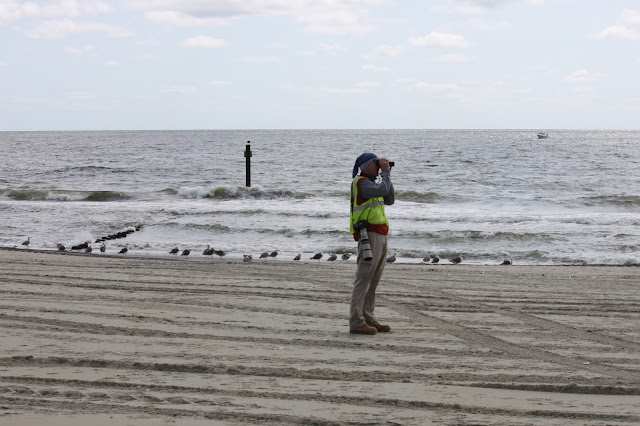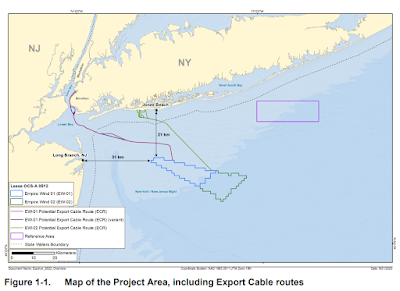The Ocean is Talking, is anybody listening?
In my last blog, I wrote about
Hurricane Sandy and how it slammed into and opened up Wreck pond to the
sea on October 29, 2012. Barely two months later, on December 27,
2012, a Noreaster hits and opens up a new inlet at Lake Takanassee in the same
way (Above image), just a few miles to the North. Local residents of the
surrounding towns are not happy about the floods that came with this event, but
they are happy because the new opening allows the floodwaters to rapidly
retreat out to sea. Local Striper fishermen look at this
destructive event from an entirely different perspective and see a long-awaited ray of hope. Finally, the vital species of forage fish that feed our
striped bass and other gamefish will be able to enter these waters like they
used to and spawn and multiply.
I visited LakeTak, as locals call it, right after Sandy hit to see the damage it had done to the old US Life Saving station. Although the historic landmark was completely leveled, I found it amazing that, other than dumping tons of sand into the back end of the lake, the spillway, and its one of a kind open wooden cradle survived.
Unfortunately, this Nor’easter a month later finished what Sandy started. The waters came up hard and fast decimating the dunes that separated the lake from the beachfront. The old wooden retention wall and the old brick spillway was exposed to the air for the first time since the early 1900s and the lake was flowing right over it, down the beach, and into the sea.
Lake Takanassee has an amazing complex and unique watershed
upstream that runs 10 miles west through woods, behind strip malls,
residential neighborhoods. The waters of Whale pond brook have great dissolved
oxygen levels which are ideal for river herring to thrive in. Designed and
created by mother nature herself, the dense vegetation and gradual sloping of
this boggy stream cleanse the waters that empty into it from the streets and
yards surrounding it.
Lake Tak has dropped 10 feet and has stopped draining somewhat
and has seemed to have found its new level. I am thinking that a temporary dam
just like the one at wreck pond will need to be erected to prevent the
lake from draining completely. County officials will most likely take advantage
of this drawdown and go ahead, dredge the lake and remove hundreds of yards
worth of years of yucky sediment and debris.
These natural events cut out years' worth of red tape and
procedural BS overnight. Now, authorities have no choice but to engineer a new system that will allow for stormwater relief, and hopefully, with angler
advocacy and correct funding, they will include migrating fish passage as a
priority.
For the past four
years, the Anglers Conservation Network (ACN) “River Herring Rescue” program
has been struggling (in vain) to find adequate funding to encourage angler
participation, erect fish ladders, and improve upriver habitat for River Herring
to be able to return to native spawning sites.
The image below shows a fish ladder installed at the dam
at Lake Carasaljo in Lakewood NJ. This allows the river herring to enter the upper lake for spawning
In the past decade,
River Herring population levels have gone from bad to worse, and just last
year, they were labeled “a species of concern” which is a notch below
“endangered”. Joining many other east coast states, in 2012 New Jersey
issued a moratorium on all directed fishing towards them. Populations are
crashing for a variety of reasons, but the past decade of pair trawling
tactics for Atlantic herring, squid, mackerel, and butterfish has the river
herring caught up mercilessly by the ton and dumped at sea as bycatch.
Although it would be
optimum to remove the dams completely, here in Jersey we have to adapt to many
of the dams that have been built as our residents simply cannot live without
the manmade lakes. The least we can do at this point is to
provide egress for our fish when they need it the most. In some of the better
spots, I have watched dozens of herring swim up the ladders and out into the
lakes to spawn. The benefits of a successful, spawning population of local
river herring to our local ecosystem, wildlife, and recreational fisherman are
immeasurable.
Just recently completed, the above photo shows that Wreck pond now has an emergency temporary low head dam built, that flows into a stream that flows down the beach to the sea. At times of incoming tides, raw seawater will still flow into the end of the pipe and into the lake, but now at astronomical high tides, the incoming tide will now flow over the dam as well.
 Alewife and Blue Back herring,
(collectively called river herring) arrive in the early spring, with the
Alewives first, then as water temps rise, the blue backs show up. Swimming up
the coast, they “home” in on the freshwater outflows and with any luck, will
choose to swim into the new beach inlet and over the low head dam.
Alewife and Blue Back herring,
(collectively called river herring) arrive in the early spring, with the
Alewives first, then as water temps rise, the blue backs show up. Swimming up
the coast, they “home” in on the freshwater outflows and with any luck, will
choose to swim into the new beach inlet and over the low head dam.
Unfortunately, The above shows the pool that the herring dead-end into. ZERO accommodation was made for fish to migrate into the calm waters above this spillway, where the Alewives prefer to spawn. This ignorance by the engineers and subcontracted firms is commonplace here in NJ and it's hard to comprehend how they can spend so much to fix a problem and not take the extra small step to put a fish and eel ladder in the plan.
Important to note that the 60 billion dollar Sandy Aid package (Bill 152) has been hung up in Congress until recently. Among all the line items in this package sits funding needed to accomplish the restoration and improvement of the above waterways with the future and our fish in mind. Shoreline restoration includes many things, rebuilding in a sensible manner, restoring wetlands, and working with nature instead of against her. We have the know-how to accommodate the massive surge of rain and seawater contained in the “100-year” storms that are now occurring with increasing frequency but we have to provide the funding to make it happen.
Many of the current republican leaders from outside our area that dominates congress just decided and voted that this was PORK and they cut the line items out completely. They made it pretty clear as to where this all stands in the scheme of things. We are currently waiting for the senate to decide. If the house majority has its way, it's clear that the majority rules and they will award the project to the lowest bidder and just rebuild it like it used to be and then do it all over again when the next storm hits and then start the process over again at double the expense year after year wasting even more taxpayer dollars. Our only hope is that the Senate will shuffle back in the fisheries aid package and shoreline restoration components… and the President will somehow sign off on it. We shall see!
The brand new fish ladder hoist has been bent and the bar is stuck down in the flume
And the pipe was damaged and repaired during the beach replenishment but it has filled with sand and we are unsure of its ability to perform as designed.
2020 should have been the first year for the herring and other species to use the pipe and ladder. At the rate we are currently going at 2021 will be a fail for the system and the ecosystem as well.
The beach was replenished this year
This road Cone marks the daylighting grate. It is essential that this grate remain clear and open. The herring use the ambient light for reassurance that they are good to go. This grate has filled in with sand at times and I know of no plan to maintain year-round and at peak times of migration.
View of the easement, with the pipe running underneath this area
While visiting the site during beach replenishment, it was cool to see/meet an federal endangered species observer, keeping an eye out for Piping Plover, Tern, skimmer and more. Local Beach guard/patrol was helpful and enthusiastic.
Shot of the Coast guard station after the fire and before the storm finished it off.
The remains of the fish ladder area after the storm























Comments
Post a Comment